




The spiders on this page are a few of the spiders that are
commonly found in gardens and yards around Portland, Oregon. Many of
these spiders may also wander into homes, crawl-spaces, and garages in
search of prey, mates, or a place to lay their eggs.
| "Web-building" Spiders | |||
 |
 |
 |
 |
"Web-building" spiders spin webs to capture prey. The type of web that a spider spins is often used to help identify it. The types of webs that different spiders may spin include orb webs, cob webs and sheet webs.
| "Wandering" Spiders | |||||
 |
 |
 |
 |
 |
 |
"Wandering" spiders do not construct webs to capture prey. They either actively pursue prey or they wait for prey to wander or fly within their reach.
"Web-building" Spiders
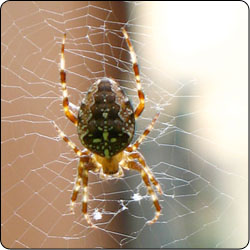 Araneus diadematus (adult female) (rollover for a slightly different color morph of an adult female) |
back to thumbnail images Common Name: Cross orbweaver Scientific Name: Araneus diadematus Family: Araneidae (the orb-web spiders) Size: Adult female body length is about 3/8 - 5/8 inch with a total length (including legs) up to about 1 1/2 inches. When gravid (with fertilized eggs), the female's abdomen may appear quite swollen, as in the above photo. Adult females are much larger than adult males. Adult male body length is about 3/8 inch, but the abdomen is much thinner than females.
Behavior: These spiders spin orb-webs to capture flying
insects. Webs are typically consumed by the spider before spinning a
replacement web. Females continue to spin webs after maturing into an adult, but males typically do not. Once mature, males wander in search of females to mate. Egg sacs are produced in autumn, and deposited under leaves or in crevices. After their eggs are laid, the adult spiders typically die. In the spring, the eggs hatch and tiny golden spiderlings emerge. When and Where to Find: This spider may be found most
anywhere near human habitations, from door frames and house eaves to
between branches of shrubs and trees. These spiders are most noticeable
in late summer, as they begin to attain their adult size. By
mid-September the females typically reach their full mature size, with large
abdomens. Female spiders need large webs to catch the many insects they need to eat to help them mature, and these webs are often constructed at eye-level, making them very noticeable. Identification: Both sexes are reddish-brown to medium brown, commonly with reddish-orange tones. A darker pyramid shape is located on the spider's dorsal abdomen, with a series of white dots and lines within it, in the shape of a cross. This white cross is what gives this spider one of its common names. Notes: Spiders are able to recycle their silk for future
use. They do this by first rolling the silken threads of their web into
a ball, and then eating the silk. |
||
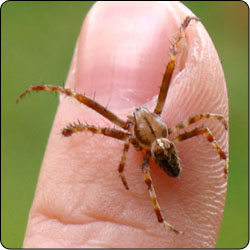 Araneus diadematus (adult male) (this spider is missing his 2nd right leg) |
|||
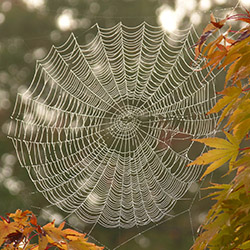 Typical orb web of Araneus diadematus |
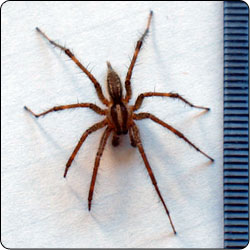 adult male grass spider |
back to thumbnail images
Common Name: Grass Spider Scientific Name: Agelenopsis sp. Family: Agelenidae (the funnel-web spiders) Size: body length is about 1/4-1/2 inch; total length (including legs) is about 1 1/4 –1 1/2 inches. Behavior: These spiders build a web that looks like a flat sheet, with a funnel-shaped retreat at the rear. The spider typically sits inside the funnel part of the web and waits for prey to wander or land on their web. They quickly run from the funnel retreat to subdue prey before dragging it back into the retreat to consume. When and Where to Find: Their common name, grass spider, belies their habitat preference. They typically build webs among grasses or other low vegetation such as ivy and mat-forming shrubs. They can be found in late spring through the summer and early fall. Identification: A sheet web with a funnel at the end is distinctive for this family, and webs of this type suggest this spider may be present. The spider is typically medium brown with a lighter midline and edge striping on the cephalothorax. The abdomen tends to have one or more lengthwise concentric areas of a lighter pattern. Long spinnerets that extend well beyond the end of the abdomen are always present. |
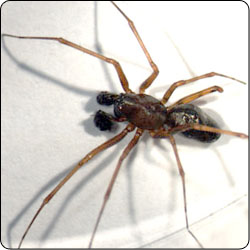 adult male linyphiid spider |
back to thumbnail images
Common Name: Filmy Dome Spider Scientific Name: Neriene Family: Linyphiidae Size: body length is 3/16 - 7/16 inches. Behavior: These spiders spin horizontal webs, and normally hang upside down from their webs while they are awaiting prey. When an insect lands on their web, they bite it from below their webs. When not feeding, they may hide in a retreat at the web's margin. When and Where to Find: Linyphiids may be found from winter through summer. They build sheet webs in sheltered locations such as under fallen logs, in hollow tree trunks or beneath overhangs. Webs may be maintained for long periods of time. Identification: The habitat and web these spiders are found in will help with their identification. Both sexes have rather long, narrow bodies with a dark brown coloration, with lighter colored legs that are longer than their bodies. Adult males possess very enlarged palps (see photo above). |
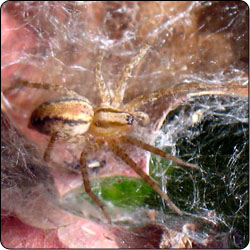 adult female Hololena |
back to thumbnail images
Common Name: no common name exists for this species of spider Scientific Name: Hololena sp. Family: Agelenidae Size: body length about 1/2 inch; total length (including legs) about 1 inch. Behavior: This spider constructs sheet webs, commonly in shrubs, with a circular retreat at the back of the web in which the spider sits-in-wait for prey to enter the web. They are usually active at night, but may opportunistically take prey during the day. When and Where to Find: Very common in summer through early fall. Look for their webs in dense shrubs and at the base of ornamental or bunch grasses. Identification: Tan to light brown, with nearly parallel dark stripes extending from the eyes to the rear of the cephalothorax. Similar dark stripes extend the length of the abdomen giving the appearance of two thin dark stripes extending from the eyes to the spinnerets. |
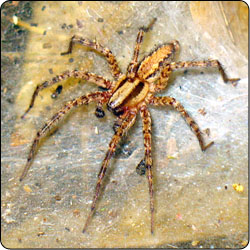 adult male Hololena |
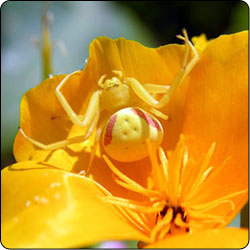 adult female crab spider (rollover for white adult female crab spider) |
back to thumbnail images
Common Name: Goldenrod Crab Spider Scientific Name: Misumena vatia Family: Thomisidae (crab spiders) Size: Males and females are sexually dimorphic, meaning they are very different in size and appearance when they are adults. Adult females have a body length of about 3/8 inch, and their abdomens can become quite large when they are gravid. Adult males are much thinner and smaller, with a body length up to 5/32 inch. Behavior: This spider sits-and-waits, typically on flowers, for insect prey to land within reach. As adults, they specialize in eating bees and flies that pollinate flowers. They wait with outstretched legs for an insect to land within grasp, then quickly grab the insect with their first two legs, and deliver a bite that paralyzes the insect. When and Where to Find: On flowers in sunny areas, and less frequently on flowers and vegetation in partially shaded habitats. Immatures can be found in spring, while adults may be found in early summer through early fall. Identification: The first and second pairs of legs are very long and extend sideways. Females are uniformly light-colored, except for a pair of red stripes extending halfway back from the front of the abdomen. Individuals can change their body color (over a few days time) to better match the flower color they are on, changing between yellow (photo), or white (rollover photo). The immature males are whitish in color, but their first two pairs of legs begin to turn dark as they mature. After their final molt when they are adults, the males' first two legs and cephalothorax are dark reddish-black, while their abdomen is pale yellow with two reddish stripes. |
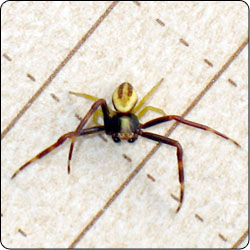 adult male crab spider |
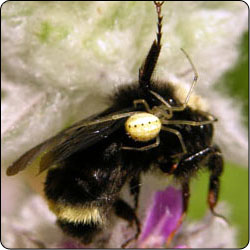 adult female Enoplognatha feeding on a bumblebee (rollover for another image) |
back to thumbnail images
Common Name: A type of cobweb spider without a common name Scientific Name: Enoplognatha ovata Family: Theridiidae (cobweb weavers) Size: adult body length about 5/32 to 9/32 inch. Behavior: This spider exhibits an unusual behavior compared to others spiders in this family. While most cobweb weavers build cobwebs designed to capture prey, Enoplognatha does not build a web, but instead actively stalks its prey. It typically bites its prey, and then may use some silk to help subdue its prey, but does not wrap it in silk. They are typically found in vegetation, and eat insects that are attracted to the flowers, or insects that rest on the leaves of the plant. When and Where to Find: During summer on vegetation frequented by pollinators. Identification: Abdomen round in shape, and much larger than cephalothorax. Abdomen white to light yellow in color, normally with two parallel rows of dots on either side of mid-line on dorsal (upper) side, extending from near cephalothorax to near spinnerets. Some individuals have pronounced red or black markings on their abdomen. |
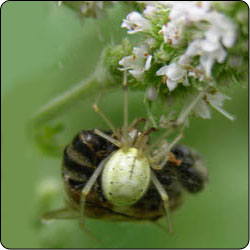 adult female Enoplognatha feeding on a honeybee |
|
back to thumbnail images
Common Name: Western lynx spider Scientific Name: Oxyopes scalaris Family: Oxyopidae (lynx spiders) Size: body length up to about 5/16 inch. Behavior: Active predators during the day. They are both sit-and-wait predators, but may also stalk their prey like a cat. They move using a characteristic darting behavior, and are capable of moving quickly. However, they also can often be found sitting still and basking in the sun, as the above male lynx spider was when photographed. When and Where to Find: Adults can be found late spring through summer, often in tall grasses or other vegetation. Identification: Body color is bronze. Many spines (macrosetae) are present on their legs, giving them a spiny appearance. |
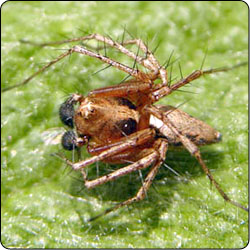 adult male lynx spider |
|
back to thumbnail images
Common Name: Thinlegged Wolf Spider Scientific Name: Pardosa sp. Family: Lycosidae (wolf spiders) Size: adult body length about 5/16 to 1/2 inch. Behavior: Daytime hunters, they actively pursue their prey. Female wolf spiders lay their eggs in an egg sac, which they then carry attached to their spinnerets. After the young hatch, the spiderlings climb onto their mother's back and cling to her until they are large enough to hunt on their own (for photos of this, see a different species of wolf spider at bottom of this page ). When and Where to Find: Very abundant and visible in early spring to early summer. In lawns, gardens, and other semi-open habitats (not common in forested habitats). Can often be observed in early morning on vegetation and rocks that are warmed by the sun. Identification: Species in this genus often possess white lines that run down the center of their bodies, but this species lacks such markings, and instead is a more uniform dark-brown to black color. |
|
back to thumbnail images
Common Name: Woodlouse Hunter Scientific Name: Dysdera crocata Family: Dysderidae Size: body length about 3/8 to 5/8 inch; length including legs, up to about 1 3/8 inches. Behavior: These nocturnal spiders prey mostly on woodlice, also commonly known as pill or sow bugs. They build retreats underground and in decaying logs in which to molt, and deposit eggs. When and Where to Find: Most commonly found in Portland from spring through fall. You are most likely to encounter them when digging in the garden, or under rocks or logs. Males may wander at night in search of females and may be seen outside their normal habitats, such as in basements and crawlspaces. Identification: The legs and cephalothorax of Dysdera are reddish-orange, and their abdomens gray-colored. A distinguishing feature of this species is the pair of large chelicerae that project forward, which allows them to prey on woodlice. |
|
back to thumbnail images
Common Name: Wolf Spider Scientific Name: Lycosid spider Family: Lycosidae (wolf spiders) Size: Varies, depending upon species. Behavior: As above described for Pardosa sp. When and Where to Find: The species pictured (possibly Pardosa distincta) is common in the Oregon coast mountains, not in Portland gardens and yards. It is included on this page because the photos depict typical wolf spider maternal behaviors, including a female carrying her egg sac, and a female carrying her newly hatched young on her abdomen. Commonly found in open areas in the summer and early fall. Identification: Body and legs variable shades of brown, often very cryptically colored, such that the spider blends in with the background it is on and therefore may be difficult to see. Cephalothorax typically dark brown with lighter median stripe. Egg sac attached to the spinnerets of adult females are characteristics of wolf spiders. Nocturnal wolf spiders possess eyes that reflect light at night. For fun: To find wolf spiders at night, shine a flashlight across the ground and look for their small eye reflections, like little glints of gold. |
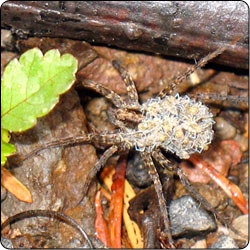 adult female wolf spider with her spiderlings clinging to her abdomen |
|
Common Name: Johnson jumper (top photo) Scientific Name: Phidippus johnsoni Common Name: bold jumper (bottom photo) Scientific Name: Phidippus audax Family: Salticidae (jumping spiders) Size: These are the largest jumping spiders you will find in the Portland area. Behavior: Jumping spiders do not build webs to hunt prey, but instead rely on their keen vision to locate and pounce upon insects. When and Where to Find: Because they stalk their prey, they often sit motionless on top of plants where flying insects are likely to land. In the cool of the day they may also sit in the sun on walls, rocks, and on top of plants. Identification: The adult spiders are easy to tell apart from other jumping spiders by their large size. Adult females will have large abdomens, as those pictured here. When they move their palps away from their face, you can see their brilliant metallic bluish-green chelicerae.
|
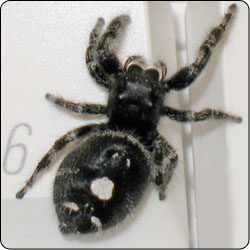 Phidippus audax |
|
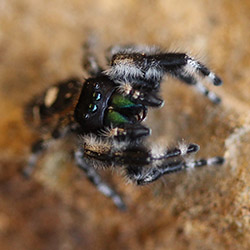 Phidippus audax |
|
Common Name: slender crab spider Scientific Name: Tibellus oblongus Family: Philodromidae (running crab spiders) When and Where to Find:These spiders are often found on vegetation, such as tall grasses or perennial and annual plants. Like true crab spiders, they do not build webs to catch prey, but instead wait for an insect to approach them. |